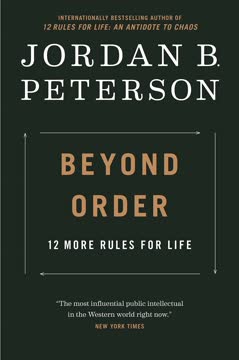Key Takeaways
1. Financial instability is inherent in capitalist economies
Capitalism is a financial system, and the financiers are the true masters of finance.
Fundamental flaw. Minsky argued that capitalist economies have a fundamental flaw: they are inherently unstable due to the nature of financial relationships. This instability stems from:
- The profit-seeking behavior of economic agents
- The use of debt to finance investments
- The interconnectedness of financial obligations
Boom and bust cycles. These factors lead to periodic booms and busts, as:
- During good times, optimism grows
- This encourages more risk-taking and borrowing
- Eventually, the system becomes fragile
- A small shock can then trigger a financial crisis
2. The "stability is destabilizing" paradox
Stability—even of an expansion—is destabilizing in that the more adventuresome financing of investment pays off to the leaders and others follow.
Complacency breeds risk. Minsky's paradox suggests that periods of economic stability encourage behaviors that ultimately lead to instability:
- During good times, economic actors become more confident
- This confidence leads to increased risk-taking
- Financial innovations emerge to circumvent regulations
- Debt levels rise as both lenders and borrowers become less cautious
Self-reinforcing cycle. The longer the period of stability, the more fragile the system becomes, setting the stage for a potential crisis.
3. Minsky's Financial Instability Hypothesis (FIH)
In this framework, crises are not due to the special characteristics of any institution; crisis-prone situations emerge out of the normal profit-seeking activities of borrowers and lenders.
Three financing stages. Minsky's FIH describes how financial structures evolve from stable to fragile:
- Hedge financing: Income covers all debt payments
- Speculative financing: Income covers interest but not principal
- Ponzi financing: Income insufficient to cover interest or principal
Inevitable progression. Over time, the economy naturally moves from hedge to speculative to Ponzi financing, increasing its vulnerability to shocks and potential crises.
4. The evolution of capitalism: From robust to fragile
The financial structure has become much more fragile; this fragility makes it likely that stagnation or even a deep depression is possible.
Stages of capitalism. Minsky identified several stages in the evolution of capitalism:
- Commercial capitalism (19th century)
- Finance capitalism (early 20th century)
- Managerial welfare-state capitalism (post-WWII)
- Money manager capitalism (late 20th century onwards)
Increasing fragility. Each stage has been characterized by:
- Greater financial complexity
- Higher debt levels
- Increased risk-taking
- More interconnected financial relationships
This progression has made the system increasingly susceptible to crises.
5. The role of Big Government and Big Bank in economic stabilization
Big Government (size, spending, taxing) and Big Bank (central bank) are lasting legacies from the Great Depression that help to constrain the natural instability of our market economy.
Countercyclical forces. Minsky argued that two main institutions help stabilize the economy:
-
Big Government (fiscal policy):
- Automatic stabilizers (e.g., unemployment benefits)
- Discretionary spending during downturns
- Maintains aggregate demand and corporate profits
-
Big Bank (monetary policy):
- Lender of last resort function
- Interest rate management
- Provides liquidity during crises
Limitations. While these institutions can mitigate crises, they cannot eliminate instability entirely and may even encourage more risk-taking in the long run.
6. Employer of Last Resort: A solution to unemployment and poverty
A necessary ingredient of any war against poverty is a program of job creation; and it has never been shown that a thorough program of job creation, taking people as they are, will not by itself, eliminate a large part of the poverty that exists.
Direct job creation. Minsky proposed an Employer of Last Resort (ELR) program to address unemployment and poverty:
- Government acts as employer of last resort
- Offers a job to anyone willing and able to work
- Pays a fixed wage (e.g., minimum wage)
- Provides a buffer stock of employed workers
Benefits of ELR:
- Reduces unemployment and poverty
- Stabilizes wages and prices
- Enhances skills and employability
- Maintains aggregate demand during downturns
7. Reforming the financial system to promote stability
As the United States struggles with the problem of fixing the financial system policy, advocates of any particular proposal need to address three questions: 1. "What is it that is taken to be broke?" 2. "What theory about how our economy works underlies the proposal?" 3. What are the dire consequences of not fixing that which you assert is broke or alternatively how does the change you advocate make things better?
Key reform areas. Minsky proposed several reforms to promote financial stability:
- Improve bank regulation and supervision
- Encourage relationship banking over transaction banking
- Limit the size and scope of financial institutions
- Reform the payments system
- Develop community development banks
- Address the shadow banking system
Continuous adaptation. Minsky emphasized that financial reform must be an ongoing process, as financial innovations will always emerge to circumvent existing regulations.
8. The limitations of mainstream economic theory
The problems we face now may well be the result of a misspecification by the theories that guided past policies of the processes that determine what happens in our type of economy.
Flawed assumptions. Minsky criticized mainstream economic theory for:
- Assuming markets are naturally stable and self-correcting
- Ignoring the role of finance and debt in economic dynamics
- Relying on equilibrium models that don't reflect real-world complexity
- Failing to account for fundamental uncertainty
Alternative approach. Minsky's work offers a more realistic view of the economy by:
- Focusing on financial relationships and cash flows
- Recognizing the inherent instability of capitalist systems
- Emphasizing the importance of institutions in shaping economic outcomes
9. The importance of cash flow analysis in banking
A commercial bank is a business enterprise. The aim of its management is similar to the aim of the management of any other business: to maximize profits while paying due attention to the various constraints within which the firm operates.
Cash flow focus. Minsky emphasized the importance of analyzing cash flows in banking:
- Banks create money by making loans
- The ability to repay depends on future cash flows
- Prudent banking requires careful underwriting and relationship-building
Shift in banking practices. Minsky observed a dangerous trend away from traditional banking:
- From relationship banking to transaction banking
- Increased reliance on securities and derivatives
- Growth of "originate to distribute" model
- Decline in underwriting standards
10. Securitization and the rise of shadow banking
At the annual banking structure and competition conference of the Federal Reserve Bank of Chicago in May 1987, the buzzword heard in the corridors and used by many of the speakers was "that which can be securitized, will be securitized."
Financial innovation. Minsky recognized the transformative power of securitization:
- Allows banks to move assets off their balance sheets
- Creates new, complex financial instruments
- Increases interconnectedness in the financial system
Shadow banking growth. The rise of securitization led to:
- Rapid growth of the shadow banking system
- Increased financial fragility
- Regulatory arbitrage
- Concentration of risk in opaque financial structures
11. Policy recommendations for a more stable capitalism
The task ahead is to reduce insecurity while ensuring "the civilized standards of an open and democratic society".
Comprehensive approach. Minsky's policy recommendations aimed to create a more stable and equitable form of capitalism:
- Maintain a large government sector to stabilize the economy
- Implement an Employer of Last Resort program
- Reform the financial system to promote stability
- Encourage smaller, community-based financial institutions
- Develop policies to reduce income inequality
- Promote high consumption rather than high investment
- Continuously adapt regulations to keep pace with financial innovations
Long-term vision. Minsky emphasized the need for ongoing policy adaptation to address the inherent instability of capitalism while promoting economic security and democracy.
Last updated:
Review Summary
Why Minsky Matters introduces readers to economist Hyman Minsky's ideas on financial instability, employment, and economic reform. Reviewers found the book informative but sometimes repetitive. Many appreciated Minsky's insights on the inherent instability of capitalism and his emphasis on the role of finance in economic cycles. Some readers felt the book was too one-sided or lacked empirical support. Overall, reviewers saw value in Minsky's unconventional perspective, particularly in light of recent financial crises, though opinions varied on his policy prescriptions.
Similar Books










Download PDF
Download EPUB
.epub digital book format is ideal for reading ebooks on phones, tablets, and e-readers.




